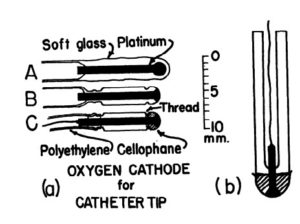As we’ve all been back from AHA19 for a few weeks now, I began thinking about the research presented. Throughout the conference I tried to focus on topics of aging and cardiovascular disease, which is my current research focus. I kept finding myself in front of posters or at talks on metabolism and my personal favorite organelle, the mitochondria.
I’ve been fascinated by mitochondria since graduate school where I ran ~300 Seahorse assays on clinical samples among other mitochondrial measures. To be clear, I was a bit burnt out on the Seahorse after my PhD but that feeling has faded. These oxygen consumption assays to measure mitochondrial function have gained popularity in recent years, which got me thinking about the origins of these devices.
The first measures of oxygen tension in blood were developed by Leland Clark1. A major limitation of measuring oxygen tension in solutions was that the liquid needed to either be quiescent or constantly stirred, which limited the use in vivo1.

Measurements I blood, which would be clinically useful, were difficult because tissues were constantly moving. Leland Clark overcame this by developing the polarographic electrode, now termed the Clark Electrode1. This became the foundation for measures of oxygen consumption rate that is the gold standard measure of mitochondrial function in isolated tissue. These are now used in the Seahorse respirometer and the Oroboros oxygraph, the 2 most popular commercial respirometers.

The development of the Clark Electrode allowed surgeons to have immediate measurements of blood oxygen during surgery, which allowed for open heart surgeries. Dr. Clark not only developed the Clark Electrode, he helped to develop the glucose monitor, which is still critical for many diabetic patients to monitor their care. He also helped to develop the first heart-lung machine helped pave the way for one of the first intensive care units in the world3.
While Dr. Clark was more concerned with measuring oxygen saturation in blood to improve direct patient care, he didn’t realize that he would also greatly advance the field of metabolism by allowing for accurate measurements of mitochondrial function. I personally owe Dr. Clark a debt of gratitude because I wouldn’t be where I am today without his pioneering inventions.
References:
- https://www.physiology.org/doi/pdf/10.1152/jappl.1953.6.3.189
- https://en.wikipedia.org/wiki/Leland_Clark#/media/File:Dr._Leland_C._Clark_Jr_2005.jpg
- https://www.ysi.com/about/history
The views, opinions and positions expressed within this blog are those of the author(s) alone and do not represent those of the American Heart Association. The accuracy, completeness and validity of any statements made within this article are not guaranteed. We accept no liability for any errors, omissions or representations. The copyright of this content belongs to the author and any liability with regards to infringement of intellectual property rights remains with them. The Early Career Voice blog is not intended to provide medical advice or treatment. Only your healthcare provider can provide that. The American Heart Association recommends that you consult your healthcare provider regarding your personal health matters. If you think you are having a heart attack, stroke or another emergency, please call 911 immediately.